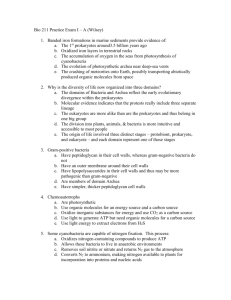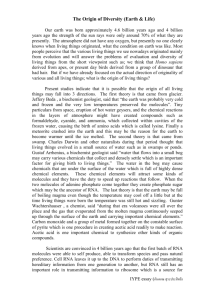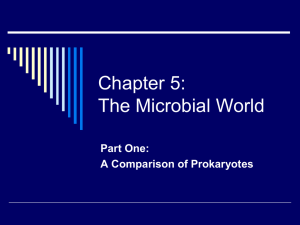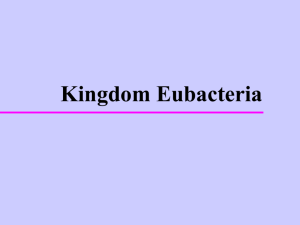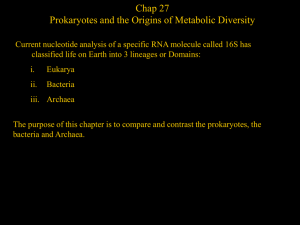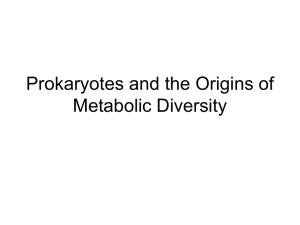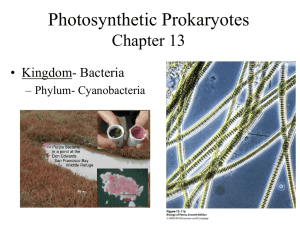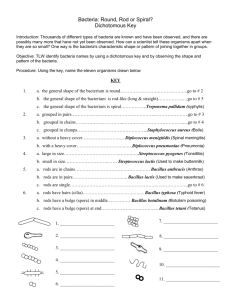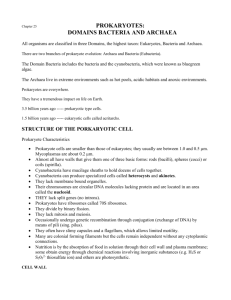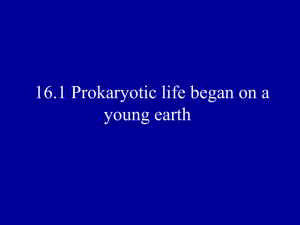Biology of Plants
advertisement
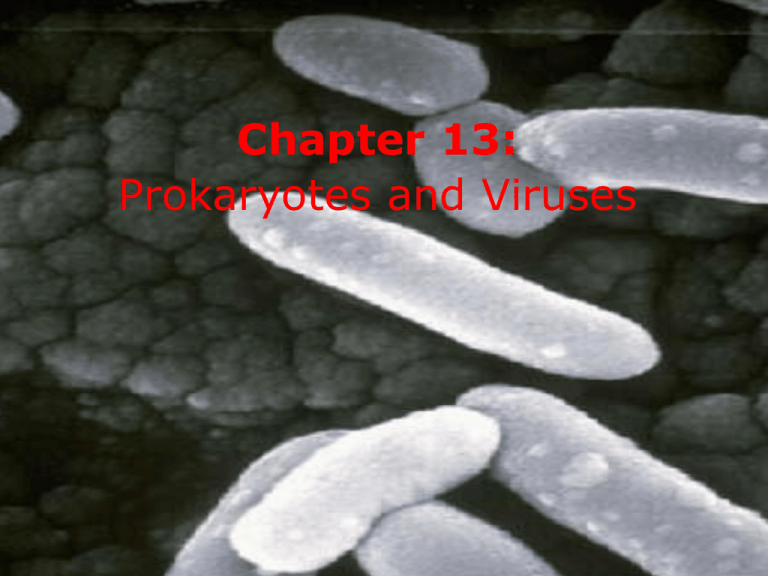
Chapter 13:
Prokaryotes and Viruses
Prokaryotes
• Oldest organisms on Earth
• The most dominant and successful forms of
life
• Great metabolic diversity and rapid rate of
growth
• Escherichia coli double in size every 20
min.
Prokaryotes
•
•
•
•
Occur in icy areas of Antarctica
Dark depths of the ocean
Near-boiling waters of hot springs
Can survive without free oxygen
What is the basic structure of a
prokaryotic cell?
• Lack an organized nucleus
• Plasma membrane and cell wall
• Nucleiod region- Singular circular
or continuous DNA molecule
(non-histone protien)
• May contain smaller
extrachromosomal pies of circular
DNA – plasmids
• Ribosomes and inclusions
• Cynobacteria is an exception
contains many thylakoids
(structure found in chloroplast
responsible for photosynthesis)
Three major forms of prokaryotes
Bacilli- rod shaped bacterium
Cocci- sphere shape
Spirilla- long curved or spiral rods
A filamentous actinomycete Streptomyces scabies
Bacterium found in soil causes potato scab disease
Prokaryotes cause disease
• Both animal and plants
• Humans (TB, cholera,
anthrax, gonorrhea, botulism,
syphilis, tetanus, ulcers)
Bacterial effects on Plants
Flagella on Pseudomonas marginalis- soil bacterium
Causes soft rot disease found in fleshy vegetables
Bacillus-Clostridium botulinum- deadly food poisoning
Bacillus can form Endospores
• Certain species of Bacteria (Bacillus
and Clostridium) can form
endospores
• Endospores- dormant bacterial cells
when food supply is low, resist heat,
radiation, chemicals,
• Protoplast is dehydrated
• Can remain viable for many years
• Viable endospore obtained from a
25-40 million year old Extinct Bee
gut
Mature Endospore- Bacillus Megaterium
Cocci- Micrococcus luteus- and others that cause
Milk to sour and oxidizes ammonia to nitrites
Another form of BacteriaSlime Bacteria
Fruiting body of myxobacterium
(Chrondomyces crocatus)
A gliding bacterium produces fruiting
Bodies, each containing 1 million
Cells (Slime Bacteria).
Slime bacteria - Psuedonomonas
• Pseudomonas corrugata
• Pith Necrosis of Tomato
Binary fission
Cell division in a bacterium
Mutation does occur and
are responsible for
evolutionary adaptability
Pilus
Donor cell
Recipient cell
Metabolic Diversity
• Some Prokaryotes are autotrophs- self
feeding
– Photosythetic
Sunlight (Energy)+ 6CO2 + 6H2O
C6H12O6 + 6O2
– Chemosythetic (chemolithotroph)
6{CO2}+6{H2O}+3{H2S}
C6H12O6+3{H2SO4}
Beggiatoa gigantea sewage Filamentous sulfur oxidizing bacteria
Spiroplasmas- motile bacteria that cause corn stunt disease
And stubborn disease
Mycoplasmiclike organism devestated a grove of
Coconut palms
Mycoplasmalike Organisms- slow weakening
General life cycle of a virus
Two stages
1. Replication inside host
2. Spread to new host
Tobacco Mosaic Virus
Streaked flowers of Rembrandt tulips
Viral infection eventually weakens plant
Wound tumor virus
Tumor produced in
sweet clover
Electron Microscope
Tumor virus particles
Prokaryotes world ecosystem
• Fixing nitrogen- incorporating nitrogen gas
into nitrogen compounds
• Autotrophic bacteria major contributor to
global carbon balance (more than 90% other
than that associated with human activity
comes from bacteria and fungi)
• Decomposers (natural and toxins)patroleum, pesticides, mercury, and dyes-
Cyanobacteria
•
•
•
Important in Carbon and nitrogen cycles
Photosynthetic cyanobacteria have chlorophyll
a, carotenoids and phycobilins.
Important lineage of bacteria and eukaryotic
cells
Limestone
Cyanobacteria electron micrograph
Cyanobacteria
Genera Oscillatoria
Cyanobacteria
Genera Nostoc commune
Plankton
• Cells of cyanobacteria living in freshwater
or marine habitats
• Plankton commonly contain bright
irregularly shaped structures – gas vesicles
• Gas vesicles provide bouancy
• When not able to regulate they float and
form mass “blooms”
• Red sea- Trichodesmium
Nitrogen fixation
• Some cyanobacteria can fix nitrogen
converting nitrogen gas to ammonium
• A form which the nitrogen is available for
biological reactions
• Occurs in Heterocyst-specialized enlarged
cells
Heterocyst
Filament of anabaena
Filament of Anabaena with heterocyst
Rice Planting Malaysia- Anabaena allow for continuous
Growing w/o fertilizer
